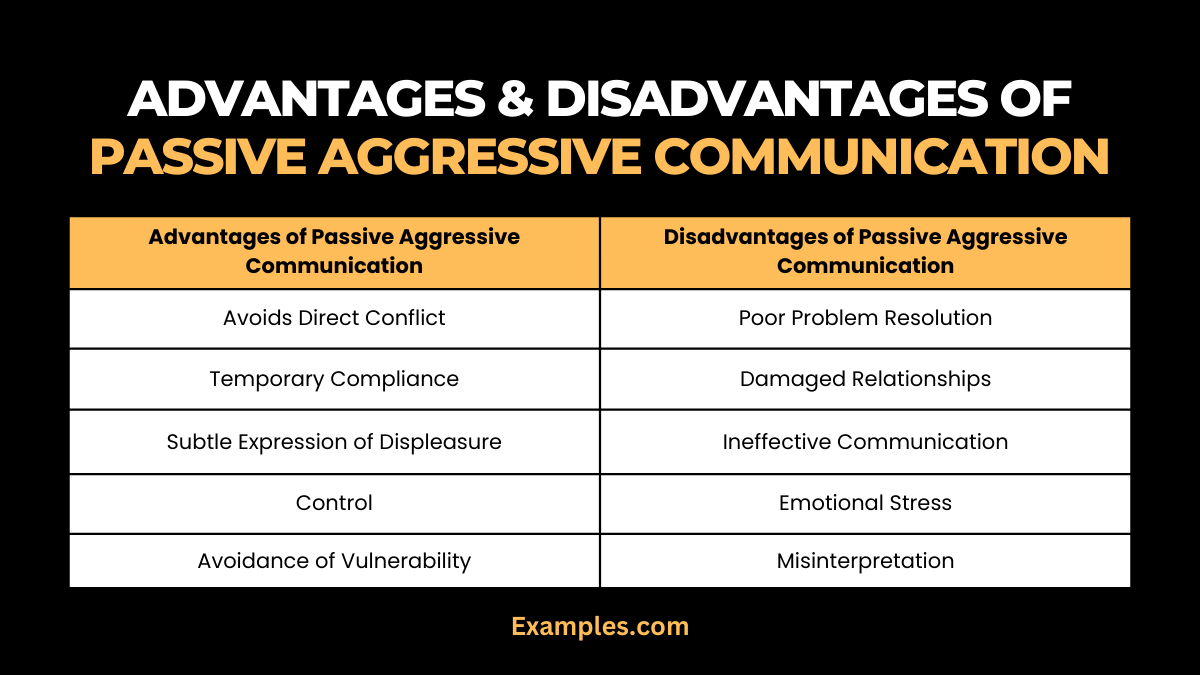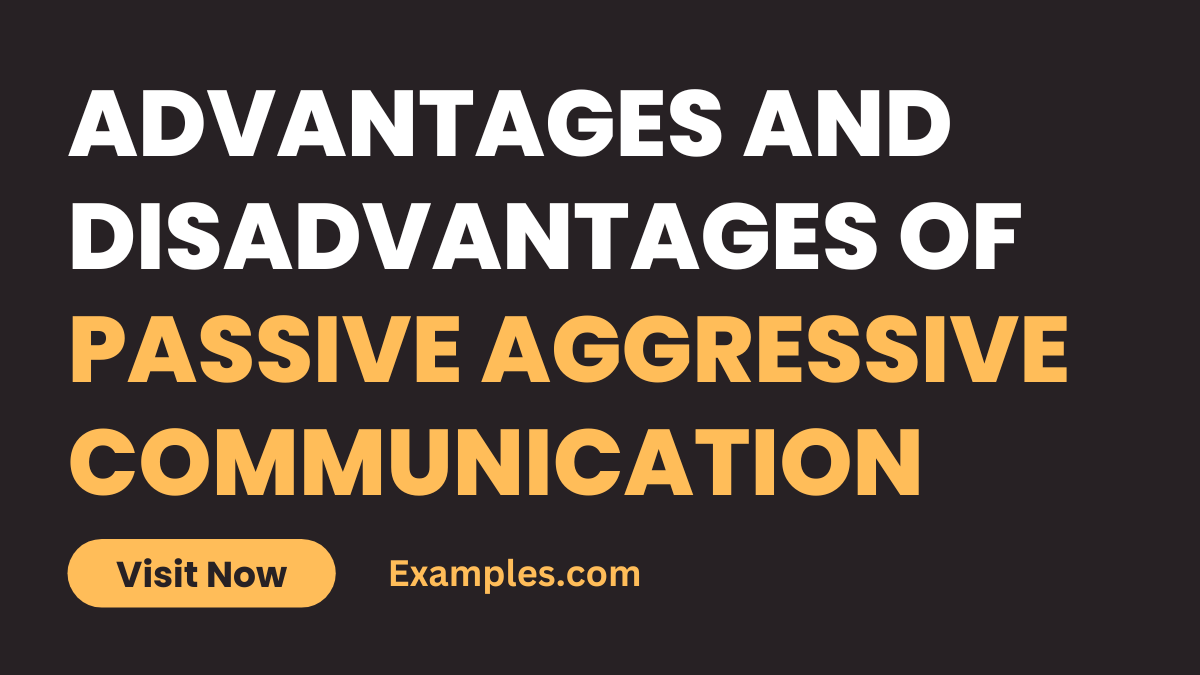Advantages & Disadvantages of Passive Aggressive Communication Examples
Understanding the Complex World of Passive Aggressive Communication can be challenging. Our complete guide delves into the intricacies of this communication style, offering real-life examples and insights. Learn about the subtle yet impactful advantages and pitfalls of passive-aggressive interactions, and discover how they can influence personal and professional relationships. This comprehensive guide not only explores the nuances of passive-aggressive behavior but also provides strategies to navigate and respond to such interactions effectively.
What are the Advantages and Disadvantages of Passive Aggressive Communication?
The advantages of passive aggressive communication include avoiding direct confrontation, which can minimize immediate conflict. It allows individuals to express displeasure without overt aggression. However, the disadvantages are significant. This communication style leads to misunderstandings, damages relationships, and creates a negative environment. It hinders effective problem-solving and can cause long-term issues in personal and professional relationships. Overall, passive aggression is an unhealthy communication style that often does more harm than good.
Advantages and Disadvantages of Passive Aggressive Communication

| Advantages of Passive Aggressive Communication | Disadvantages of Passive Aggressive Communication |
|---|---|
| Avoids Direct Conflict: Less risk of immediate confrontation. | Poor Problem Resolution: Issues remain unresolved. |
| Temporary Compliance: Can keep peace in the short term. | Damaged Relationships: Leads to trust issues and misunderstandings. |
| Subtle Expression: Allows expression of displeasure without directness. | Ineffective Communication: True feelings and needs are not clearly expressed. |
| Control: Gives a sense of control over situations. | Emotional Stress: Causes internal and relational stress. |
| Avoidance of Vulnerability: Protects from exposing real emotions. | Misinterpretation: Actions and words can be easily misunderstood. |
Advantages and Disadvantages of Passive Aggressive Communication Essay
The essay on the “Advantages and Disadvantages of Passive Aggressive Communication” can include a detailed exploration of both the benefits and drawbacks of this communication style. The table provides a concise overview, which can be expanded upon in the essay.
Advantages
- Avoids Direct Conflict: It minimizes immediate confrontations, providing a sense of safety for those uncomfortable with open disagreements.
- Temporary Compliance: This approach can maintain surface-level harmony in various settings, like workplaces or family gatherings.
- Subtle Expression of Displeasure: Allows individuals to express discontent without being straightforward, which can feel safer emotionally.
- Control: Gives a sense of control in situations where direct expression feels risky.
- Avoidance of Vulnerability: Protects individuals from the discomfort of exposing true feelings.
Disadvantages
- Poor Problem Resolution: Issues remain unresolved, leading to a buildup of unresolved conflicts.
- Damaged Relationships: Creates trust issues and misunderstandings, weakening personal and professional relationships.
- Ineffective Communication: Fails to convey true feelings and needs, leading to misinterpretation and confusion.
- Emotional Stress: Generates internal and relational stress, impacting mental health.
- Misinterpretation: Actions and words can be misunderstood, leading to further complications and conflicts.
Pros and Cons of Passive Aggressive Communication
| Pros of Passive Aggressive Communication | Cons of Passive Aggressive Communication |
|---|---|
| 1. Avoids Immediate Conflict: Temporarily prevents direct arguments. | 1. Unresolved Issues: Problems are not addressed, leading to buildup. |
| 2. Maintains Surface Harmony: Keeps peace in short-term situations. | 2. Damages Relationships: Erodes trust and understanding. |
| 3. Indirect Expression of Feelings: Provides emotional safety. | 3. Ineffective Communication: Fails to convey true feelings and needs. |
| 4. Sense of Control: Feels safer than direct confrontation. | 4. Creates Emotional Stress: Causes internal and relational tension. |
| 5. Protects from Vulnerability: Shields from exposing real emotions. | 5. Leads to Misinterpretation: Actions and words can be misunderstood. |
Pros and Cons of Passive Aggressive Communication Essay
The pros and cons of passive aggressive communication involve a balance between avoiding immediate conflict and the long-term impact on relationships. Pros include temporarily preventing direct arguments, maintaining surface harmony in certain situations, providing a way to express feelings indirectly, offering a sense of control over emotional expression, and protecting individuals from the vulnerability of direct confrontation.
Pros of Passive Aggressive Communication
- Avoids Immediate Conflict: This approach can prevent direct confrontations, beneficial in sensitive environments where open conflict might be disruptive.
- Maintains Surface Harmony: Passive aggression can maintain a semblance of peace, particularly in professional settings where overt conflict is frowned upon.
- Indirect Expression of Feelings: It provides a way for individuals to express dissatisfaction without direct confrontation, which can feel emotionally safer for some.
- Sense of Control: Passive aggression can offer a feeling of control over situations where individuals feel powerless or unable to express themselves openly.
- Protects from Vulnerability: This communication style can shield individuals from the discomfort of exposing true emotions, acting as a defensive mechanism.
Cons of Passive Aggressive Communication
- Unresolved Issues: This approach often leads to a buildup of unresolved conflicts, as issues are not directly addressed.
- Damages Relationships: It erodes trust and understanding, leading to strained personal and professional relationships.
- Ineffective Communication: Passive aggression fails to convey the true feelings and needs of the individual, resulting in misunderstandings and miscommunication.
- Creates Emotional Stress: This communication style can lead to internal and relational tension, impacting overall mental health.
- Leads to Misinterpretation: Actions and words can often be misunderstood, leading to further complications and conflicts in relationships.
In summary, while passive aggressive communication might offer short-term relief from direct confrontations, it typically leads to longer-term relational and personal difficulties. It’s important to recognize these patterns and work towards more open and effective forms of communication.
However, the cons are significant, including unresolved issues due to a lack of direct communication, damaging relationships through eroded trust, ineffective communication of true feelings and needs, causing emotional stress, and leading to misinterpretations due to unclear communication. These aspects highlight the complexity and potential drawbacks of relying on passive aggressive communication.
In conclusion, while passive aggressive communication can temporarily avoid conflict and protect from vulnerability, it ultimately leads to unresolved issues, strained relationships, and ineffective communication. Recognizing and addressing this communication style is vital for fostering healthy relationships and ensuring clear, direct interaction in both personal and professional settings.



